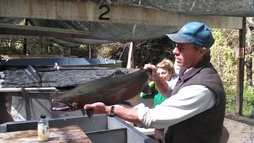Species in the Spotlight





On the Brink of Extinction
In the fifth decade of the Endangered Species Act, NOAA rededicates itself to ensuring we do not lose any species. The ESA has been successful in preventing species extinctions—less than 1 percent of the species listed under the ESA have been delisted because of extinction. While we have recovered and delisted a small percentage of listed species since 1973, we would likely have seen hundreds of species go extinct without the ESA. Under the ESA, NOAA manages 125 endangered and threatened marine species. Of all the species NOAA protects under the ESA, NOAA considers eight among the most at risk of extinction in the near future. As a result, NOAA has launched the “Species in the Spotlight: Survive to Thrive” initiative, a concerted effort to spotlight and save these highly at-risk species. Two of the 14 California salmonid species were considered most at risk:
- Central California Coho Salmon
- Sacramento River Winter-run Chinook
The six other highly at-risk species include Atlantic Salmon (Gulf of Maine), Cook Inlet Beluga Whale, Hawaiian Monk Seal, Pacific Leatherback Sea Turtle, Southern Resident Killer Whale and White Abalone.
NOAA Action Plans
In February 2016, NOAA Fisheries released 5-Year Action Plans that outline efforts vital for stabilizing their populations and preventing their extinction, and serve as road maps for their recovery.
- Central California Coho Salmon Action Plan NMFS’ recovery strategy has three priorities: (1) expand conservation hatchery programs to rebuild self-sustaining wild populations as habitats are restored; (2) focus restoration and outreach in priority watersheds – Lagoon at Scott Creek in Santa Cruz; Garcia River Estuary Restoration, Land Purchase/Easement & Outreach Project; Ten Mile River Estuary and Winter Refugia Habitat Restoration; and (3) invest in monitoring and research that supports and informs conservation hatchery programs, restoration, and status assessments.
- Sacramento River Winter-run Chinook Action Plan NMFS’ recovery strategy has five priorities: (1) improve management of Shasta Reservoir coldwater storage; (2) restore and provide access to Battle Creek habitat; (3) re-introduce water-run Chinook salmon into the McCloud River; (3) improve Yolo Bypass fish habitat and passage; (4) manage winter and early spring Delta conditions to improve juvenile survival.
The key actions that follow represent a small subset of the recovery actions identified in the 2012 and 2014 recovery plans for the two species, and represent actions NMFS and partners can take in the next five years to promote recovery of the species.